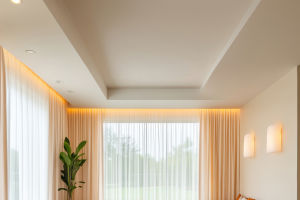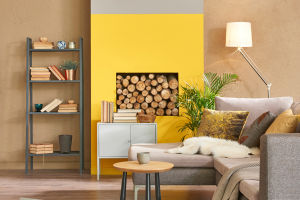Ever look around your living room and think, “This could look so much better… but the budget says no”? The heart of the home doesn’t need a luxury price tag to feel polished and inviting.
With a few smart swaps, a little creativity, and some rethinking of what you already own, your space can look beautifully styled on a small budget.
Invite Nature
One of the easiest ways to refresh a living room is by bringing in natural elements. A single leafy plant near the sofa, a trailing plant on a shelf, or a compact tree in a corner instantly adds height, movement, and color. Choose low-maintenance varieties or good-quality faux options if light or time are limited.
Natural grasses, branches, or dried stems are another budget-friendly touch. Place them in a simple vase on a console or coffee table to add texture and a sculptural feel. Many can be gathered from a garden or park, making them practically cost-free while still feeling sophisticated.
Shuffle Layout
Rearranging what you already own is a completely free makeover tool. Start by clearing clutter and removing pieces that no longer serve a purpose. Then experiment with new layouts: pull seating closer together to create a conversation zone, or angle a chair toward a window to frame a view.
Pay attention to pathways so the room is easy to move through. If walking from one seat to another feels like dodging obstacles, edit out at least one piece. A lighter layout nearly always feels more expensive than a crowded one.
Paint For Impact
A can of paint can transform a tired living room faster than almost anything else. Deep hues can make the space feel cocoon-like and intimate, while soft, light tones brighten and visually enlarge the room. Choose colors that work with existing furniture rather than fighting it.
Consider painting just one feature wall or the back of shelves if a full repaint isn’t in the cards. Even refreshing a marked skirting board or a scuffed door can make the entire room feel cleaner and more intentional.
Make It Personal
A truly inviting living room reflects the people who use it. Frame travel photos, old family snapshots, or maps of meaningful places and create a small gallery wall. Handwritten recipes, letters, or genealogical charts can become artwork when framed simply.
Layer in pieces with history: a handed-down lamp, a vintage box, or a well-loved side table picked up from a secondhand shop. These items add character and depth that brand-new decor often can’t match—at a fraction of the price.
Bold Focal Points
You don’t need a room full of expensive pieces to make it look stylish; you just need one or two stars. Choose a single bold rug, a dramatic piece of art, or a statement chair and let it shine against more neutral surroundings.
Keep walls, large sofas, and window treatments quieter so the statement element stands out instead of competing. This “one showstopper, many basics” approach looks curated and modern while keeping costs under control.
Mix Save Splurge
Strategic splurging stretches a budget further. Invest in one hardworking item—a durable sofa, a beautifully framed artwork, or quality wallpaper on a single accent wall—and surround it with more affordable pieces. Textiles are a clever place to mix price points. Cushion covers can feature a luxe fabric on the front and a simpler fabric on the back. A high-quality throw styled over a budget-friendly armchair instantly elevates the whole corner.
Reinvent Old Finds
Secondhand stores, markets, and online resale platforms are treasure troves for living room decor. Look for solid pieces with good bones: a sturdy table, a wooden chest, or an old ladder. With light sanding, paint, or new hardware, they can feel bespoke. A vintage trunk can double as both coffee table and storage. Woven baskets corral magazines or crafts while adding natural warmth. Slipcovers or reupholstery give tired chairs and sofas new life without the cost of starting from scratch.
DIY Wall Art
Blank walls can be intimidating, but buying large-scale art isn’t always necessary. Simple DIY pieces can look surprisingly chic. Paint broad stripes, blocks of color, or soft abstract shapes on inexpensive canvases. Stick to a limited palette that echoes your room’s textiles.
For a different look, create collages from fabric scraps, decorative paper, or meaningful photos. Hang a trio of coordinating pieces above a sofa or mantel for a custom, gallery-style moment that feels thoughtfully designed.
Layer Your Rugs
Rugs are powerful tools for changing the mood of a living room. Start with an inexpensive, large rug in a neutral tone to ground the space. Then layer a smaller patterned or textured rug on top in the seating area to add interest and define the zone.
Even in a small room, try to place at least the front legs of sofas and chairs on the rug so everything feels connected. A unified foundation instantly makes the space look more pulled together and considered.
Curate Collections
Collections—whether books, ceramics, or souvenirs—look best when displayed with intention. Group similar items by color, shape, or material on shelves or a console. Odd-number groupings often feel more relaxed and pleasing than perfectly mirrored arrangements. Rotate pieces seasonally rather than displaying everything at once. This keeps surfaces from feeling cluttered and allows each object to stand out. The result is personal, colorful decor that costs little more than thoughtful styling time.
Upgrade Accessories
Small enhancements can completely change the feel of existing accessories. Add trim to simple curtains, sew contrasting bands onto plain cushions, or attach tassels and fringe to throws. Swap standard lamp shades for fabric-covered versions or ones with subtle texture.
These details shift budget pieces into “custom” territory. Even something as simple as decanting items into matching baskets or boxes makes surfaces look neater and more curated, which always reads as more luxurious.
A beautiful living room doesn’t depend on an unlimited budget; it depends on creativity, intention, and a few smart tricks. Which of these budget-friendly ideas will you try first, and how do you imagine your living room feeling once you’ve given it a thoughtful, low-cost glow-up?


